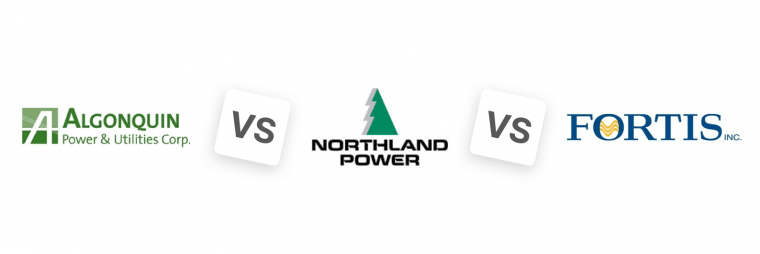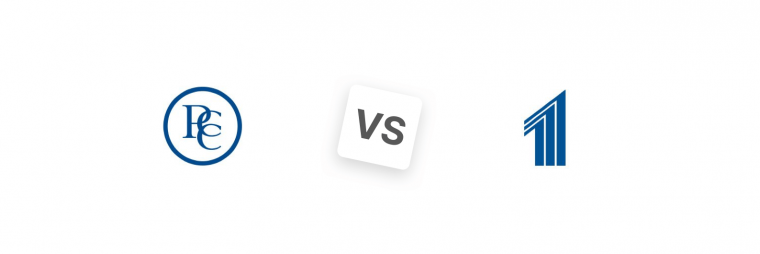Battle of the Stocks: Canada, Round 2

It’s another round of Battle of the Stocks. This week we focus on clusters of Canadian stocks that investors commonly compare, and weigh the strengths and drawbacks of each. Here we go:

Alimentation Couche-Tard vs. Parkland Fuel
Couche-Tard is one of those darlings of Bay Street, lauding the stock for regularly growing its earnings and withstanding market downturns. It recently split two-for-one, and currently trades just below $40, 10% off its 52-week high of $44.20. Brett Girard likes ATD.B for consistently raising its dividend by 10% each year, but that dividend pays only 0.63%.
This is no income stock.
Rather, investors like ATD.B for buying other gas stations in Quebec (where they’re based) Ontario or Europe. (Brian Madden suspects they will expand into Asia). ATD.B synergizes those new stations well, and enjoys wide margins in selling fresh food, adds James Telfser. Look for an entry point when markets rotate out of consumer staples.
However, David Baskin prefers Parkland Fuel, often nicknamed “mini-Alimentation Couche-Tard” because it’s also a gas station/convenience store chain that grows by acquisition, lately in the U.S. The markets have responded this year by pushing the stock up 23% year-to-date vs. ATD.B‘s 19%.
The stocks’ five-year chart gains are nearly identical, with Parkland just edging out Alimentation. Baskin also likes PKI for its profitable refinery assets, though Telfser suspects the stock has gotten ahead of itself and is wary of its valuation, now at 20x (though ATD.B‘s is over 23x). PKI, however, pays a far bigger dividend than ATD.B, at 2.73%.
Verdict: Which stock to buy comes down to your preference: do you want some income or not? Both stocks enjoy positive outlooks, similar long-term stock performance and relatively close PE. Or you can do what Bruce Campbell (of Campbell and Lee) does and own both.

Algonquin Power vs. Northland Power vs. Fortis
With declining interest rates, investors are flocking to utilities to satisfy their yield fix. Green energy with its fixed revenues and strong ESG have boomed recently, and these three names commonly pop up in discussions. (Boralex too, though a little less often.) Generally, analysts recommend all three utilities, but which is right for you?
PE ratio: Algonquin has the highest at 29x, with Northland at 16x and Fortis near 15x. Dividend yield: Northland pays the most at 4.56%, Algonquin at 4.13% and Fortis at 3.49%. Stock performance in 2019: Year-to-date, Algonquin (AQN) easily beats its peers, soaring over 33%, followed by Fortis just above 20% and Northland slightly below 20%. Bruce Campbell (of Campbell and Lee) reflects the street’s consensus by touting AQN‘s high, safe dividend, and seeing upside whenever AQN makes an acquisition.
However, he doesn’t see AQN leaping by another third to $24, so recommends buying it below $18. In fact, Algonquin recently raised money to pay down debt and dipped below $18. As for Northland (NPI), it recently made an acquisition in Colombia (good), but its founder sold a lot of shares (bad). James Telfser warns that NPI is more likely than its peers to get hit with an earnings surprise, but he’d still buy it.
Analysts like David Driscoll doubt NPI‘s dividend will rise for a while as the company pays down debt, though Varun Anand has high hopes for NPI‘s future, because the utility boasts expertise in off-shore wind power which will enjoy tremendous growth worldwide. (NPI‘s assets are in Canada and Europe.) Fortis will also enjoy growth, says Brian Madden. FTS should grow around 5% annually, though its valuation has stretched with the stock price which has leapt 33% in the past 12 months. The street consensus is: solid stock, good to hold long-term, but has run up lately, so take some profits.
Verdict: If you want income, buy AQN. If you want stock appreciation, choose AQN or NPI. For a safe, long-term investment, pick up Fortis on a pullback. If you can’t choose, any of these is good. (Disclosure: I own AQN and NPI)

Power Corp. vs. Power Financial
These two are often confused. Essentially, Power Corp. (POW-T) is the parent, and Power Financial (PWF-T) is the kid. Don’t expect much excitement from either, says the street. They’re in insurance where interest rates tickle actuarial returns, but those rates are currently low and will likely getting lower. Specifically, PWF is exposed to Great West Life, Investors Group and Mackenzie Investments. Robert Lauzon sees in PWF stability, a great 5.92% dividend and decent returns (high-single digit including the divvy). Greg Newman feels you can buy it now at a low PE of 11x.
In contrast, POW-T trades at a 14.3x PE and pays a lower 5.31% dividend. It’s a weak buy for Brian Madden due to its low beta of 0.8 to 1. The divvy is safe, adds Christine Poole, but there’s little capital appreciation, limited by the weak performance of its subsidiaries.
Verdict: POW and PWF are income stocks, and that’s basically it. Both of their charts have been rangebound for the last five years. Maybe collecting safe dividends during a downturn or expected recession is a good thing, but you won’t get rich with either. I’d give the edge to PWF because of its slightly higher dividend.




